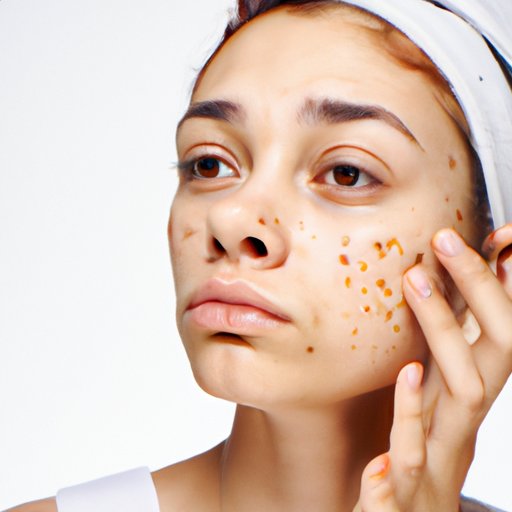Introduction
Acne is a common skin condition that affects people of all ages. It manifests as red bumps, whiteheads, blackheads, and cysts, and it can occur on the face, chest, back, and other areas of the body. One particularly problematic area is the forehead, where acne can be difficult to treat due to its location and the amount of sweat and oil that accumulates there.
The good news is that there are several steps you can take to reduce the appearance of acne on your forehead. This article will provide an overview of these steps and explain how you can use them to get rid of acne on your forehead.

Use a Gentle Cleanser Twice a Day
Using a gentle cleanser twice a day is one of the most effective ways to get rid of acne on your forehead. Cleaning your skin helps remove dirt, oil, and sweat from your pores, which can reduce the occurrence of breakouts. When selecting a cleanser, opt for one that is free of fragrances, dyes, and harsh chemicals, which can irritate your skin and make acne worse.
When washing your face, use warm water and a soft cloth or your fingertips. Gently massage the cleanser into your skin in a circular motion and rinse thoroughly with cool water. Pat your face dry with a clean towel and apply a light moisturizer if desired.

Avoid Touching or Picking at the Area
It can be tempting to pick or touch acne on your forehead, but this can actually worsen the condition. Picking at the area can spread bacteria and cause inflammation, leading to more breakouts. Additionally, squeezing pimples can lead to scarring.
To prevent yourself from touching or picking at the area, keep your hands away from your face as much as possible. If you feel the urge to pick at your skin, try using a cold compress or applying an over-the-counter hydrocortisone cream to soothe the area. Additionally, avoid wearing hats or headbands that can irritate the skin.
Use Topical Treatments
Topical treatments can also be used to reduce the appearance of acne on your forehead. Products containing salicylic acid and benzoyl peroxide are often recommended as they help unclog pores and reduce inflammation. When using these products, start with a low concentration and gradually increase if needed. Be sure to follow the instructions on the label and avoid using too much of the product, as this can lead to dryness and irritation.
If you have sensitive skin, opt for a non-comedogenic moisturizer instead. These products are gentler on the skin and won’t clog pores. Additionally, look for products that contain natural ingredients such as tea tree oil, aloe vera, and chamomile, which can help soothe the skin.
Eat a Healthy Diet
Eating a healthy diet is key to reducing acne on your forehead. Foods that are high in vitamins A, C, and E, as well as zinc, are beneficial for skin health. Incorporate plenty of fresh fruits and vegetables, lean proteins, and whole grains into your diet. Additionally, limit your intake of processed foods, sugar, and dairy, as these can trigger breakouts.
Also, make sure you are drinking enough water throughout the day. Staying hydrated helps flush out toxins and can improve the overall appearance of your skin.
Apply an Oil-Free Moisturizer
Using an oil-free moisturizer is important for keeping your skin hydrated without clogging your pores. Look for a lightweight, non-comedogenic formula that won’t cause breakouts. Apply the moisturizer after cleansing and allow it to absorb into your skin before applying makeup or sunscreen.
In addition to providing hydration, an oil-free moisturizer can help protect your skin from environmental stressors such as pollution and UV rays. Choose a product that contains SPF 30 or higher for optimal protection.
Try Light Therapy or Chemical Peels
Light therapy and chemical peels are two additional options for treating acne on your forehead. Light therapy involves exposing your skin to certain wavelengths of light, which can reduce inflammation and kill bacteria. Chemical peels involve applying a chemical solution to the skin, which removes the top layer of dead skin cells. Both treatments can be performed in a dermatologist’s office and may require multiple sessions for best results.
Before undergoing either treatment, consult with your doctor to ensure it is safe for you. Additionally, make sure to follow any post-treatment instructions provided by your doctor to maximize the benefits of the treatment and minimize potential side effects.
Conclusion
Getting rid of acne on your forehead can be challenging, but it is possible. Start by using a gentle cleanser twice a day and avoiding touching or picking at the area. Additionally, use topical treatments, eat a healthy diet, and apply an oil-free moisturizer. For more severe cases, consider trying light therapy or chemical peels.
By following these steps, you can reduce the appearance of acne on your forehead and achieve clearer, healthier-looking skin. For more information, talk to your doctor or visit acne.org.


